Three Decades after: Landscape Dynamics in Different Colonisation Models Implemented in the Brazilian Legal Amazon
Abstract
:1. Introduction
2. Materials and Methods
2.1. Study Area
2.2. Satellite Data and LULC Mapping
2.3. LULC Dynamics Analysis—Transition Probabilities and Anthropised Areas Rates
3. Results
3.1. Land-Use and Land-Cover Changes
3.2. Paths and Trends of Colonisation
3.3. Settlers Responses
4. Discussion
5. Conclusions
Author Contributions
Funding
Data Availability Statement
Acknowledgments
Conflicts of Interest
Appendix A
Appendix B
References
- Aguiar, A.P.D.; Vieira, I.C.G.; Assis, T.O.; Dalla-Nora, E.L.; Toledo, P.M.; Santos-Junior, R.A.O.; Batistella, M.; Coelho, A.S.; Savaget, E.K.; Aragao, L.E.O.C.; et al. Land use change emission scenarios: Anticipating a forest transition process in the Brazilian Amazon. Glob. Chang. Biol. 2016, 22, 1821–1840. [Google Scholar] [CrossRef]
- Almeida, C.A.; Coutinho, A.C.; Esquerdo, J.C.D.M.; Adami, M.; Venturieri, A.; Diniz, C.G.; Dessay, N.; Durieux, L.; Gomes, A.R. High spatial resolution land use and land cover mapping of the Brazilian Legal Amazon in 2008 using Landsat-5/TM and MODIS data. Acta Amaz. 2016, 46, 291–302. [Google Scholar] [CrossRef]
- Assunção, J.; Gandoura, C.; Pessoa, P.; Rocha, R. Property-level assessment of change in forest clearing patterns: The need for tailoring policy in the Amazon. Land Use Policy 2017, 66, 18–27. [Google Scholar] [CrossRef]
- Ludewigs, T.; D’Antona, A.O.; Brondízio, E.S.; Hetrick, S. Agrarian Structure and Land-cover Change Along the Lifespan of Three Colonisation Areas in the Brazilian Amazon. World Dev. 2009, 37, 1348–1359. [Google Scholar] [CrossRef]
- Armenteras, D.; Murcia, U.; Gonzalez, T.M.; Baron, O.J.; Arias, J.E. Scenarios of land use and land cover change for NW Amazonia: Impact on forest intactness. Glob. Ecol. Conserv. 2019, 17, e00567. [Google Scholar] [CrossRef]
- Pacheco, P. Agrarian Reform in the Brazilian Amazon: Its Implications for Land Distribution and Deforestation. World Dev. 2009, 37, 1337–1347. [Google Scholar] [CrossRef]
- Carvalho, T.S.; Domingues, E.P.; Horridge, J.M. Controlling deforestation in the Brazilian Amazon: Regional economic impacts and land-use change. Land Use Policy 2017, 64, 327–341. [Google Scholar] [CrossRef] [Green Version]
- Dias, L.C.P.; Pimenta, F.M.; Santos, A.B.; Costa, M.H.; Ladle, R.J. Patterns of land use, extensification, and intensification of Brazilian agriculture. Glob. Chang. Biol. 2016, 22, 2887–2903. [Google Scholar] [CrossRef]
- Montibeller, B.; Kmoch, A.; Virro, H.; Mander, U.; Uuemaa, E. Increasing fragmentation of forest cover in Brazil’s Legal Amazon from 2001 to 2017. Sci. Rep. 2020, 10, 5803. [Google Scholar] [CrossRef] [PubMed]
- Carreiras, J.M.B.; Pereira, J.M.C.; Campagnolo, M.L.; Shimabukuro, Y.E. Assessing the extent of agriculture/pasture and secondary succession forest in the Brazilian Legal Amazon using SPOT VEGETATION data. Remote Sens. Environ. 2006, 101, 283–298. [Google Scholar] [CrossRef]
- Ochoa-Quintero, J.M.; Gardner, T.A.; Rosa, I.; Ferraz, S.F.B.; Sutherland, W.J. Thresholds of species loss in Amazonian deforestation frontier landscapes. Conserv. Biol. 2015, 29, 440–451. [Google Scholar] [CrossRef]
- Vasconcelos, S.S.; Fearnside, P.M.; Graça, P.M.L.A.; Dias, D.V.; Correia, F.W.S. Variability of vegetation fires with rain and deforestation in Brazil’s state of Amazonas. Remote Sens. Environ. 2013, 136, 199–209. [Google Scholar] [CrossRef]
- Ometto, J.P.; Sousa-Neto, E.R.; Tejada, G. Land Use, Land Cover and Land Use Change in the Brazilian Amazon (1960–2013). In Interactions between Biosphere, Atmosphere and Human Land Use in the Amazon Basin; Ecological Studies, Analysis and Synthesis; Nagy, L., Forsberg, B.R., Artaxo, P., Eds.; Springer: Berlin/Heidelberg, Germany, 2016; Volume 227, pp. 369–384. [Google Scholar]
- Rosa, I.M.D.; Purves, D.; Souza, J.R.C.; Ewers, R.M. Predictive Modelling of Contagious Deforestation in the Brazilian Amazon. PLoS ONE 2013, 8, e77231. [Google Scholar] [CrossRef] [PubMed] [Green Version]
- Göpel, J.; Hissa, L.B.V.; Schüngel, J.; Schaldach, R. Sensitivity assessment and evaluation of a spatially explicit land-use model for Southern Amazonia. Ecol. Inform. 2018, 48, 69–79. [Google Scholar] [CrossRef]
- Llopart, M.; Reboita, M.S.; Coppola, E.; Giorgi, F.; Rocha, R.P.; Souza, D.O. Land Use Change over the Amazon Forest and Its Impact on the Local Climate. Water 2018, 10, 149. [Google Scholar] [CrossRef] [Green Version]
- Busse, M.; Siebert, R. Acceptance studies in the field of land use—A critical and systematic review to advance the sconceptualisation of acceptance and acceptability. Land Use Policy 2018, 76, 235–245. [Google Scholar] [CrossRef]
- Muller, H.; Griffiths, P.; Hostert, P. Long-term deforestation dynamics in the Brazilian Amazon—Uncovering historic frontier development along the Cuiabá-Santarém highway. Int. J. Appl. Earth Obs. Geoinf. 2016, 44, 61–69. [Google Scholar] [CrossRef]
- Soler, L.S.; Escada, M.I.S.; Verburg, P.H. Quantifying deforestation and secondary forest determinants for different spatial extents in an Amazonian scolonisation frontier (Rondonia). Appl. Geogr. 2009, 29, 182–193. [Google Scholar] [CrossRef]
- Godara, J.; Toby, A.; Gardner, T.A.; Tizado, E.J.; Pacheco, P. Actor-specific contributions to the deforestation slowdown in the Brazilian Amazon. Proc. Natl. Acad. Sci. USA 2014, 111, 15591–15596. [Google Scholar] [CrossRef] [Green Version]
- Gollnow, F.; Hissa, L.B.V.; Rufin, P.; Lakes, T. Property-level direct and indirect deforestation for soybean production in the Amazon region of Mato Grosso, Brazil. Land Use Policy 2018, 78, 377–385. [Google Scholar] [CrossRef]
- Schielein, J.; Börner, J. Recent transformations ofland-use and land-cover dynamics across different deforestation frontiers in the Brazilian Amazon. Land Use Policy 2018, 76, 81–94. [Google Scholar] [CrossRef]
- De Toledo, P.; Dalla-Nora, E.L.; Vieira, I.C.G.; Aguiar, A.P.D.; Araújo, R. Development paradigms contributing to the transformation of the Brazilian Amazon: Do people matter? Curr. Opin. Environ. Sustain. 2017, 26, 77–83. [Google Scholar] [CrossRef]
- Nobre, C.A.; Sampaio, G.; Borma, L.S.; Castilla-Rubio, J.C.; Silva, J.S.; Cardoso, M. Land-use and climate change risks in the Amazon and the need of a novel sustainable development paradigm. Proc. Natl. Acad. Sci. USA 2016, 113, 10759–10768. [Google Scholar] [CrossRef] [PubMed] [Green Version]
- Dale, V.H.; O’Neill, R.V.; Pedlowski, M.; Southworth, F. Causes and effects of land-use change in Central Rondônia, Brazil. Photogramm. Eng. Remote Sens. 1993, 59, 997–1005. [Google Scholar]
- Escada, M.I.S. Evolução de Padrões da Terra na Região Centro-Norte de Rondônia. Ph.D. Thesis, Instituto Nacional de Pesquisas Espaciais (INPE), São José dos Campos, Brazil, 2003; 264p. INPE-10209-TDI/899. [Google Scholar]
- Moran, E.; Ostrom, E.; Randolph, J.C.E. A Multilevel Approach to Studying Global Environmental Change in Forest Ecosystems; Working Paper; Center for the Study of Institutions, Population, and Environmental Change and Workshop in Political Theory and Policy Analysis, Indiana University: Bloomington, IN, USA, 1998. [Google Scholar]
- Fearnside, P. The Impact of Land Use on Carbon Stocks and Fluxes in Brazilian Amazonia: Implications for Policy. In Interactions between Biosphere, Atmosphere and Human Land Use in the Amazon Basin; Ecological Studies, Analysis and Synthesis; Nagy, L., Forsberg, B.R., Artaxo, P., Eds.; Springer: Berlin/Heidelberg, Germany, 2016; Volume 227, pp. 385–406. [Google Scholar]
- Radambrasil, P. Cartographer. Porto Velho—Folha SC.20. 1978. Available online: https://library.wur.nl/isric/fulltext/isricu_i00006758_001.pdf (accessed on 23 October 2019).
- Breiman, L. Random forests. Mach. Learn. 2001, 45, 5–32. [Google Scholar] [CrossRef] [Green Version]
- Ma, Z.; Redmond, R.L. Tau coefficients for accuracy assessment of classification of remote sensing data. Photogramm. Eng. Remote Sens. 1995, 61, 435–439. [Google Scholar]
- Guzha, A.C.; Rufino, M.C.; Okoth, S.; Jacobs, S.; Nóbrega, R.L.B. Impacts of land use and land cover change on surface runoff, discharge and low flows: Evidence from East Africa. J. Hydrol. Reg. Stud. 2018, 15, 49–67. [Google Scholar] [CrossRef]
- Carrero, G.C.; Fearnside, P.M.; Valle, D.R.; Alves, C.S. Deforestation Trajectories on a Development Frontier in the Brazilian Amazon: 35 Years of Settlement Colonization, Policy and Economic Shifts, and Land Accumulation. Environ. Manag. 2020, 66, 966–984. [Google Scholar] [CrossRef]
- Flamenco-Sandoval, A.; Ramos, M.M.; Masera, O.R. Assessing implications of land-use and land-cover change dynamics for conservation of a highly diverse tropical rain forest. Biol. Conserv. 2007, 138, 131–145. [Google Scholar] [CrossRef]
- FAO. Forest Resources Assessment 1990: Survey of Tropical Forest Cover and Study of Change Processes; FAO: Rome, Italy, 1996. [Google Scholar]
- Cinlar, E. Introduction to Stochastic Processes; Prentice-Hall: Englewood Cliffs, NJ, USA, 1975. [Google Scholar]
- Balzter, H. Markov chain models for vegetation dynamics. Ecol. Model. 2000, 126, 139–154. [Google Scholar] [CrossRef] [Green Version]
- Puyravaud, J.P. Standardising the calculation of the annual rate of deforestation. For. Ecol. Manag. 2003, 177, 593–596. [Google Scholar] [CrossRef]
- Yanai, A.M.; Graça, P.M.L.A.; Escada, M.I.S.; Ziccardi, L.G.; Fearnside, P.M. Deforestation dynamics in Brazil’s Amazonian settlements: Effects of land-tenure concentration. J. Environ. Manag. 2020, 268, 110555. [Google Scholar] [CrossRef] [PubMed]
- Sanchez, A.H.; Picoli, M.C.A.; Camara, G.; Andrade, P.R.; Chaves, M.E.D.; Lechler, S.; Soares, A.R.; Marujo, R.F.B.; Simões, R.E.O.; Ferreira, K.R.; et al. Comparison of Cloud Cover Detection Algorithms on Sentinel–2 Images of the Amazon Tropical Forest. Remote Sens. 2020, 12, 1284. [Google Scholar] [CrossRef] [Green Version]
- Neves, A.K.; Körting, T.S.; Fonseca, L.M.G.; Escada, M.I.S. Assessment of TerraClass and MapBiomas data on legend and map agreement for the Brazilian Amazon biome. Acta Amaz. 2020, 50, 170–182. [Google Scholar] [CrossRef]
- Silva, C.H.L., Jr.; Aragão, L.E.O.C.; Fonseca, M.G.; Almeida, C.T.; Vedovato, L.B.; Anderson, L.O. Deforestation-Induced Fragmentation Increases Forest Fire Occurrence in Central Brazilian Amazonia. Forests 2018, 9, 305. [Google Scholar] [CrossRef] [Green Version]
- Silva, A.A.; Braga, M.Q.; Ferreira, J.; Santos, V.J.; Alves, S.C.; Oliveira, J.C.; Calijuri, M.L. Anthropic activities and the Legal Amazon: Estimative of impacts on forest and regional climate for 2030. Remote Sens. Appl. Soc. Environ. 2020, 18, 100304. [Google Scholar] [CrossRef]
- Silveira, M.V.F.; Petri, C.A.; Broggio, I.S.; Chagas, G.O.; Macul, M.S.; Leite, C.C.S.S.; Ferrari, E.M.M.; Amim, C.G.V.; Freitas, A.L.R.; Motta, A.Z.V.; et al. Drivers of Fire Anomalies in the Brazilian Amazon: Lessons Learned from the 2019 Fire Crisis. Land 2020, 9, 516. [Google Scholar] [CrossRef]
- Silva, S.S.; Fearnside, P.M.; Graça, P.M.L.A.; Brown, I.F.; Alencar, A.; Melo, A.W.F. Dynamics of forest fires in the southwestern Amazon. For. Ecol. Manag. 2018, 424, 312–322. [Google Scholar] [CrossRef]
- Sathler, D.; Adamo, S.B.; Lima, E.E.C. Deforestation and local sustainable development in Brazilian Legal Amazonia: An exploratory analysis. Ecol. Soc. 2018, 23, 30. [Google Scholar] [CrossRef] [Green Version]
- Scolforo, J.R.S.; Mello, J.M. Inventário Florestal; UFLA: Lavras, Brazil, 2006; 561p. [Google Scholar]
- Moura, V.; Rossell, E.C.F.; Mascarenhas, A.R.P. Análise fitossociológica de uma floresta ombrófila aberta em diferentes modelos de colonização da Amazônia. Nativa 2017, 5, 118–126. [Google Scholar] [CrossRef]
- Guerrero, J.V.R.; Escobar-Silva, E.V.; Chaves, M.E.D.; Mataveli, G.A.V.; Bourscheidt, V.; de Oliveira, G.; Picoli, M.C.A.; Shimabukuro, Y.E.; Moschini, L.E. Assessing Land Use and Land Cover Changes in the Direct Influence Zone of the Braço Norte Hydropower Complex, Brazilian Amazonia. Forests 2020, 11, 988. [Google Scholar] [CrossRef]
- Maretto, R.V.; Fonseca, L.M.G.; Jacobs, N.; Körting, T.S.; Bendini, H.N.; Parente, L.L. Spatio-Temporal Deep Learning Approach to Map Deforestation in Amazon Rainforest. IEEE Geosci. Remote Sens. Lett. 2021, 18, 771–775. [Google Scholar] [CrossRef]
- Moura, V.; Carvalho, L.M.T.; Pereira, J.A.A. Utilização de Informações Orbitais no Monitoramento do Desmatamento na Amazônia Legal. 2011. Available online: http://urlib.net/3ERPFQRTRW/3A4TFDS (accessed on 22 April 2021).
- Garrett, R.D.; Koh, I.; Lambin, E.F.; Waroux, Y.P.; Kastens, J.H.; Brown, J.C. Intensification in agriculture-forest frontiers: Land use responses to development and conservation policies in Brazil. Glob. Environ. Chang. 2018, 53, 233–243. [Google Scholar] [CrossRef]
- Becker, B. Geopolítica na Amazônia: A Nova Fronteira de Recursos; Zahar: Rio de Janeiro, Brazil, 1982. [Google Scholar]
- Teixeira, L.S. Dinâmicas Territoriais em Rondônia: Conflitos Fundiários Entorno do Projeto Integrado de Colonização Sidney Girão (1970–2004). Master’s Thesis, PUCRS—Porto Alegre, Porto Alegre, Brazil, 2015. [Google Scholar]
- Santos, T.R.S.; Ricarte, C.A.A.; Conceição, F.S. Rondônia—Mutações de um território federal na Amazônia brasileira. Confins 2016, 29. [Google Scholar] [CrossRef]
- Jakimow, B.; Griffiths, P.; van der Linden, S.; Hostert, P. Mapping pasture management in the Brazilian Amazon from dense Landsat time series. Remote Sens. Environ. 2018, 205, 453–468. [Google Scholar] [CrossRef]
- Kim, D.-H.; Sexton, J.O.; Townshend, R. Accelerated deforestation in the humid tropics from the 1990s to the 2000s. Geophys. Res. Lett. 2015, 42, 3495–3501. [Google Scholar] [CrossRef] [PubMed]
- Leitão, R.P.; Zuanon, J.; Mouillot, D.; Leal, C.G.; Hughes, R.M.; Kaufmann, P.R.; Villéger, S.; Pompeu, P.S.; Kasper, D.; Paula, F.R.; et al. Disentangling the pathways of land use impacts on the functional structure of fish assemblages in Amazon streams. Ecography 2018, 41, 219–232. [Google Scholar] [CrossRef]
- Maus, V.; Câmara, G.; Cartaxo, R.; Sanchez, A.; Ramos, F.M.; Queiroz, G.R. A Time-Weighted Dynamic Time Warping Method for Land-Use and Land-Cover Mappin. IEEE J. Sel. Top. Appl. Earth Obs. Remote Sens. 2016, 9, 3729–3739. [Google Scholar] [CrossRef]
- Batistella, M. Landscape Change and Land-Use/Land-Cover Dynamics in Rondônia, Brazilian Amazon. Ph.D. Thesis, Center for Study of Institutions, Population and Environmental Change, Indiana University, Bloomington, IN, USA, 2001; 257p. [Google Scholar]
- IBGE. Censo 2017. 2020. Available online: https://www.ibge.gov.br/estatisticas/economicas (accessed on 18 July 2021).
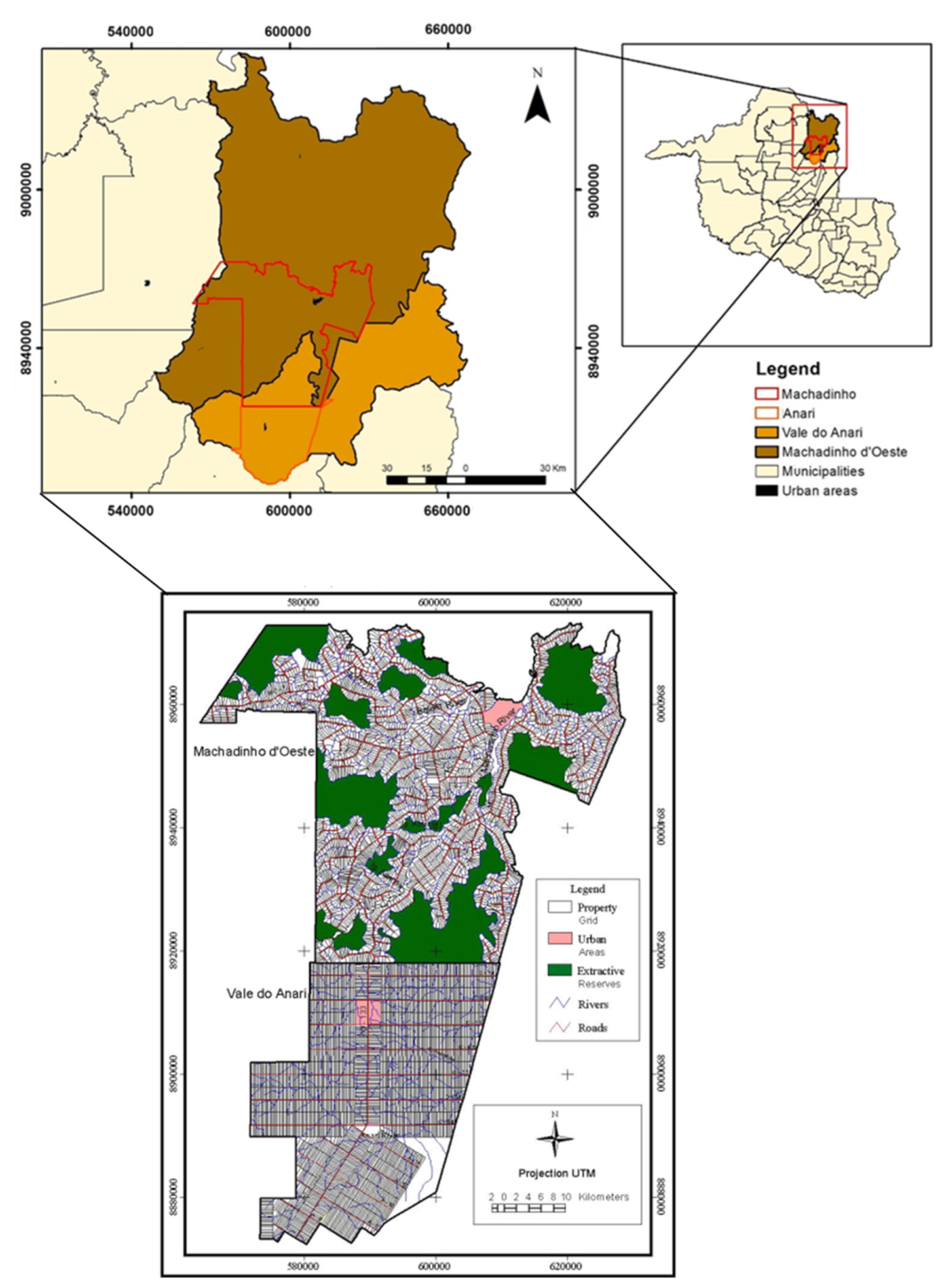
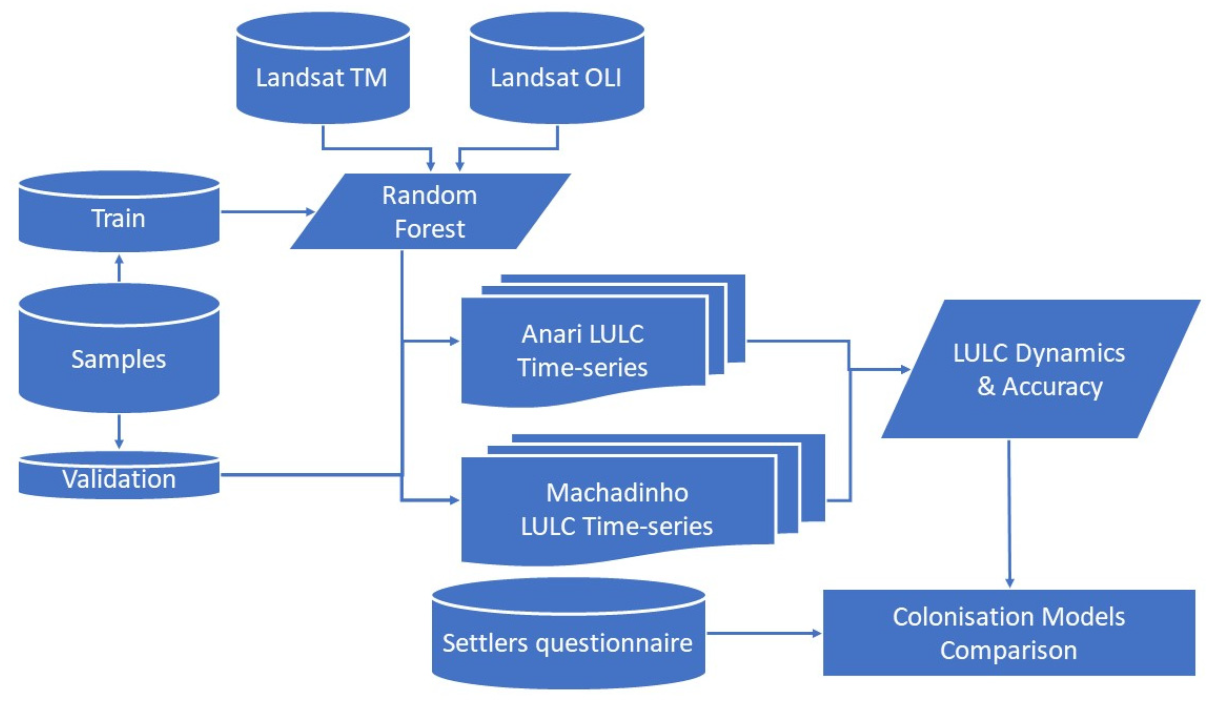
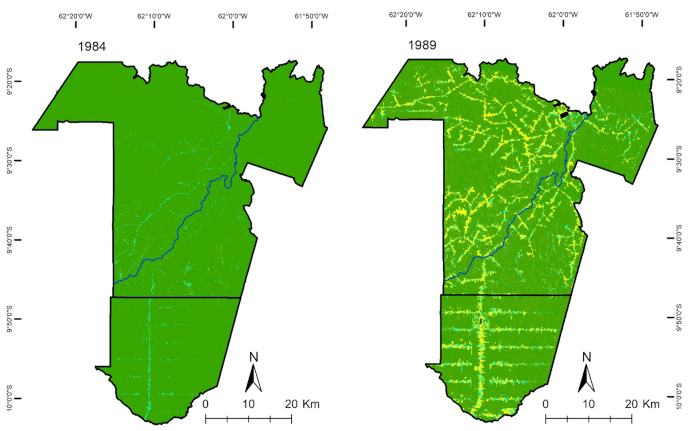
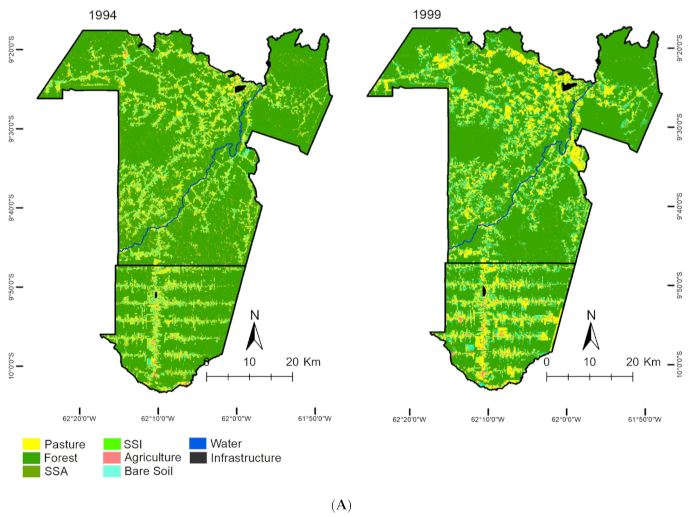
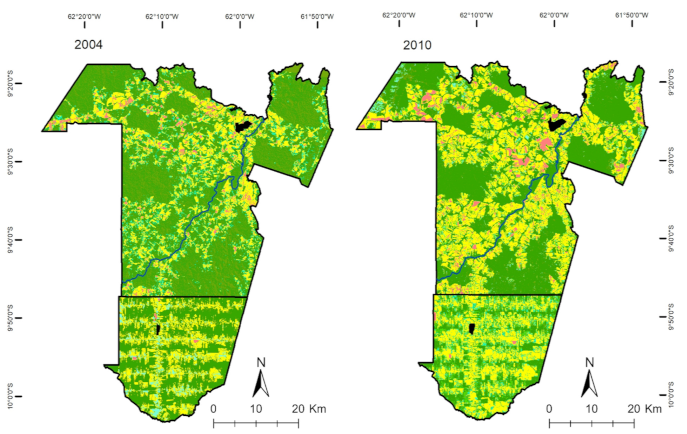
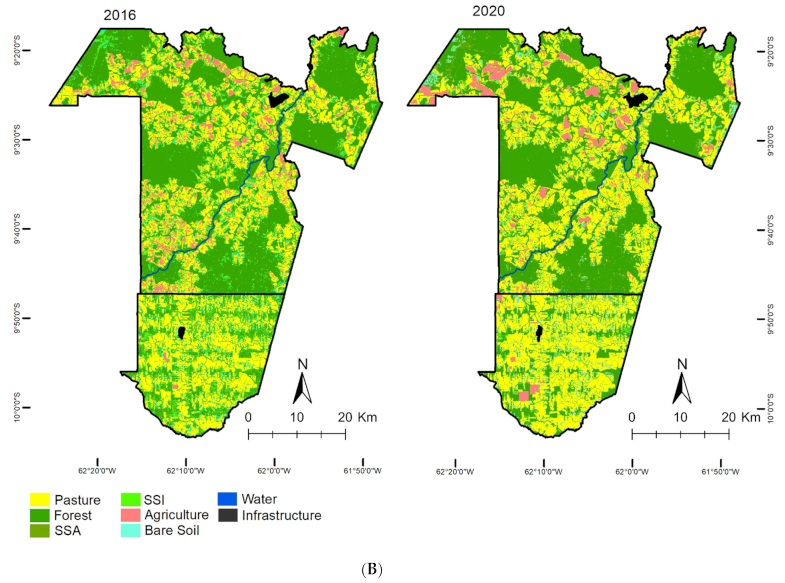

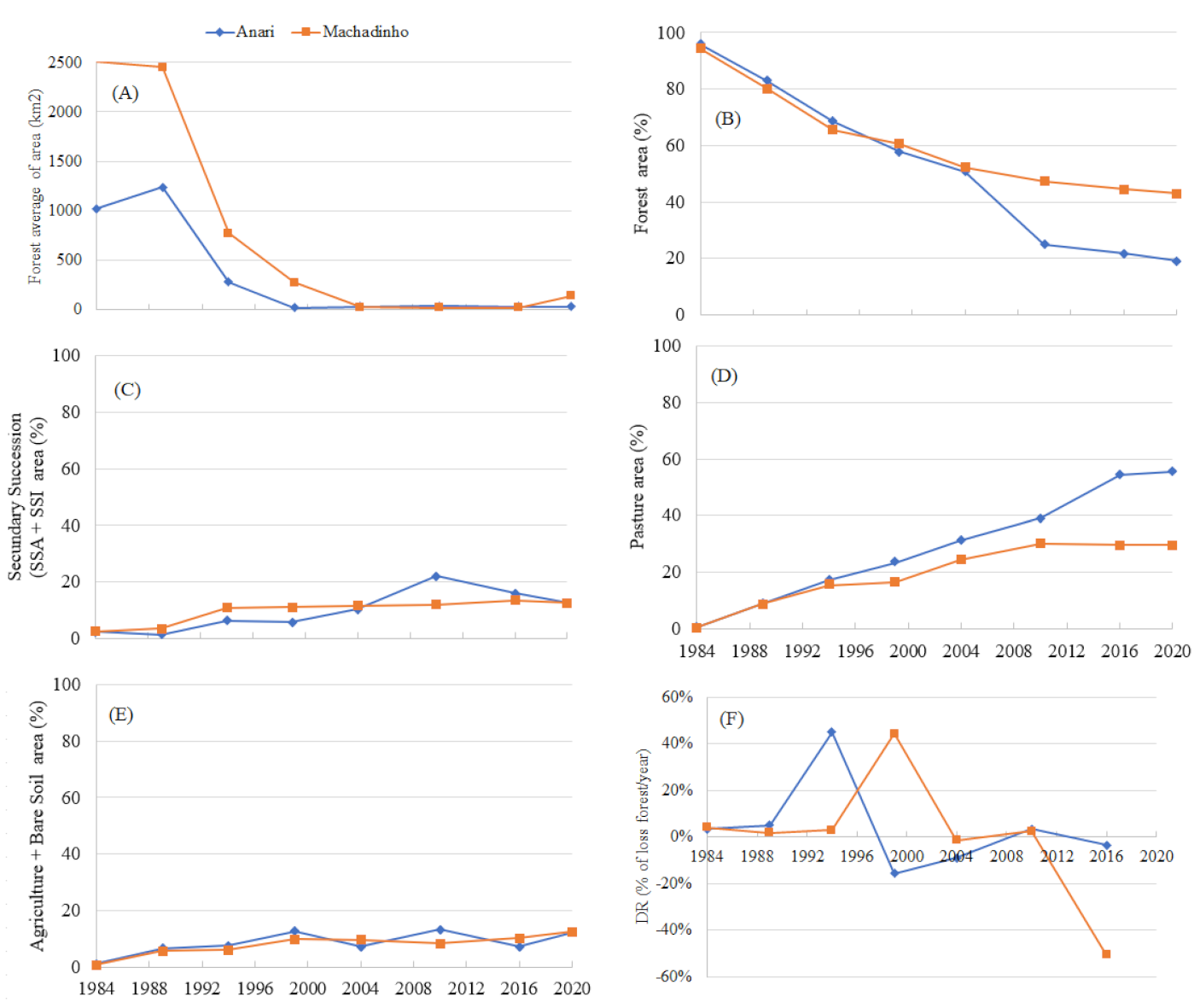
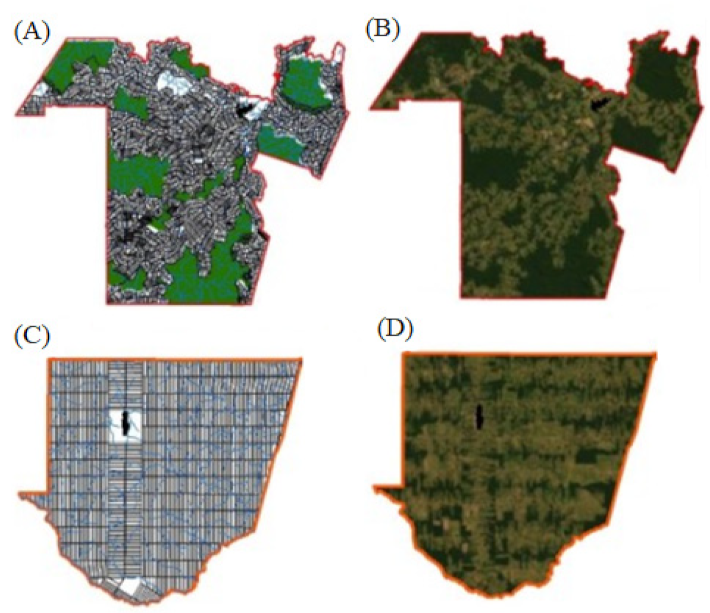

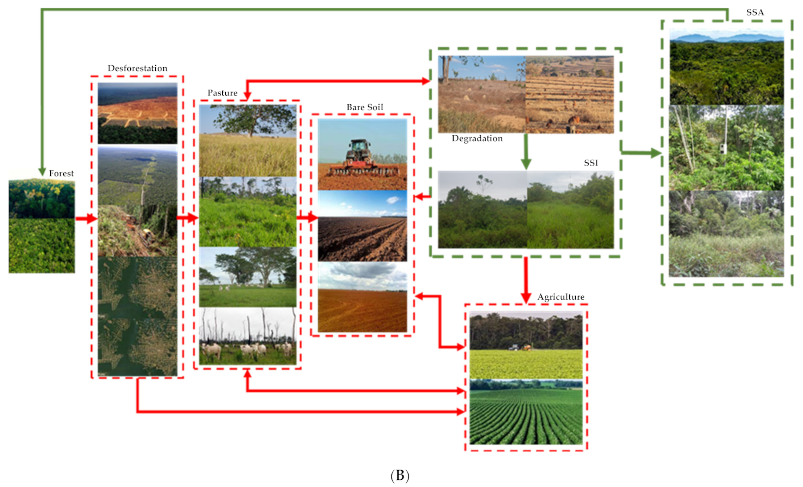
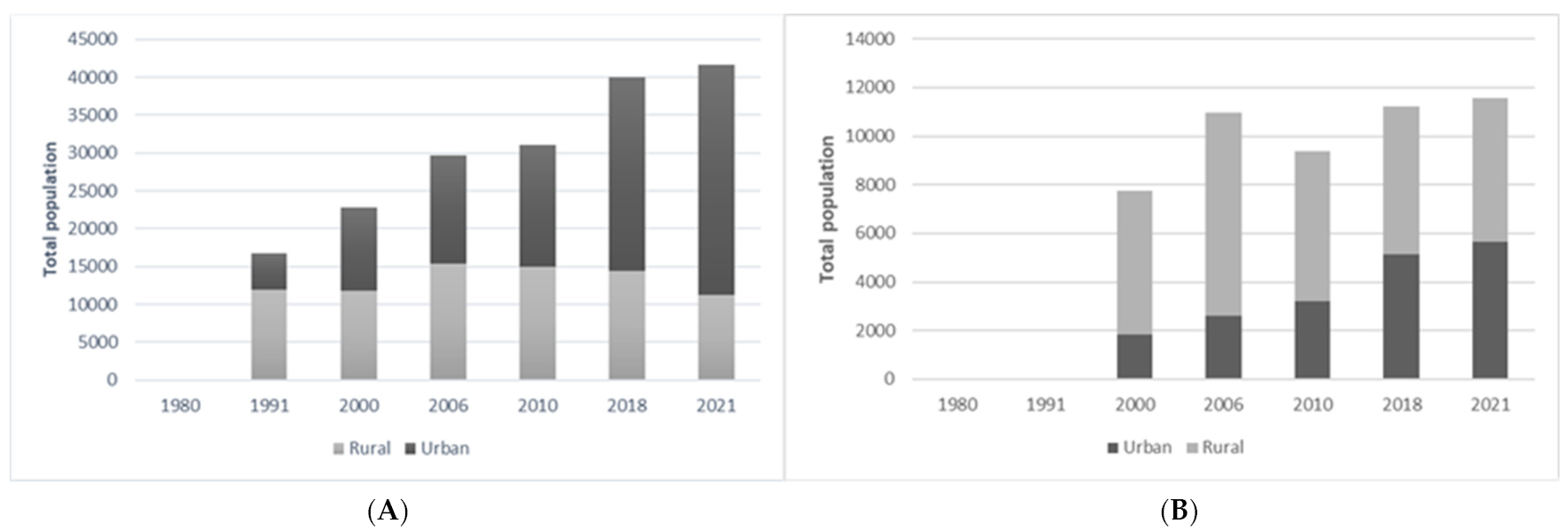
| Classes LULC | 1984 | 1989 | 1994 | 1999 | 2004 | 2010 | 2016 | 2020 | ||||||||
|---|---|---|---|---|---|---|---|---|---|---|---|---|---|---|---|---|
| PU | PP | PU | PP | PU | PP | PU | PP | PU | PP | PU | PP | PU | PP | PU | PP | |
| Forest | 92.4 | 90.8 | 89.3 | 94.1 | 87.9 | 92.5 | 88.7 | 94.6 | 91.7 | 95.8 | 90.6 | 93.8 | 96.7 | 97.1 | 98.7 | 98.9 |
| SSA | 65.9 | 79.6 | 60.9 | 68.7 | 59.7 | 64.5 | 59.1 | 69.2 | 60.4 | 67.3 | 51.8 | 59.4 | 72.4 | 78.9 | 83.4 | 85.7 |
| SSI | 66.5 | 81.2 | 61.9 | 67.9 | 54.8 | 61.9 | 62.7 | 69.1 | 53.7 | 63.9 | 52.3 | 61.2 | 79.3 | 81.7 | 87.6 | 88.2 |
| Pasture | 89.6 | 78.7 | 90.7 | 86.8 | 92.1 | 87.3 | 91.2 | 89.6 | 90.4 | 85.9 | 90.1 | 83.9 | 95.9 | 90.7 | 93.2 | 95.8 |
| Agriculture | 84.9 | 81.6 | 89.6 | 81.9 | 90.8 | 89.3 | 92.7 | 89.8 | 92.5 | 90.6 | 94.3 | 91.2 | 95.2 | 97.9 | 99.4 | 99.6 |
| Bare Soil | 85.9 | 94.8 | 91.2 | 93.7 | 92.4 | 94.1 | 93.9 | 94.8 | 91.7 | 93.5 | 92.2 | 94.6 | 96.8 | 97.5 | 99.1 | 99.4 |
| Infrastructure | 82.8 | 100 | 87.9 | 100 | 89.7 | 100 | 88.9 | 100 | 90.6 | 100 | 92.3 | 100 | 98.5 | 100 | 98.7 | 100 |
| Water | 91.3 | 100 | 92.3 | 100 | 94.5 | 100 | 91.8 | 92.3 | 92.5 | 100 | 94.2 | 98.1 | 98.2 | 98.7 | 99.5 | 99.6 |
| Accuracy | 85.3 | 84.8 | 84.5 | 85.5 | 85.0 | 83.8 | 91.8 | 93.4 | ||||||||
| Kappa | 79.5 | 81.1 | 81.0 | 81.7 | 80.8 | 80.7 | 90.6 | 91.8 | ||||||||
| Class LULC | 1984 | 1989 | 1994 | 1999 | 2004 | 2010 | 2016 | 2020 | ||||||||
|---|---|---|---|---|---|---|---|---|---|---|---|---|---|---|---|---|
| Area (km2) | % | Area (km2) | % | Area (km2) | % | Area (km2) | % | Area (km2) | % | Area (km2) | % | Area (km2) | % | Area (km2) | % | |
| For | 2009.95 | 94.36 | 1704.93 | 80.04 | 1395.01 | 65.49 | 1290.01 | 60.56 | 1111.65 | 52.19 | 1007.29 | 47.29 | 946.63 | 44.44 | 915.19 | 42.97 |
| SSA | 52.83 | 2.48 | 69.99 | 3.29 | 139.06 | 6.53 | 141.03 | 6.62 | 194.52 | 9.13 | 117.56 | 5.52 | 132.93 | 6.24 | 118.50 | 5.56 |
| SSI | 0.89 | 0.04 | 2.37 | 0.11 | 89.77 | 4.21 | 92.31 | 4.33 | 51.62 | 2.42 | 135.82 | 6.38 | 153.51 | 7.21 | 148.95 | 6.99 |
| Past | 6.05 | 0.28 | 182.90 | 8.59 | 325.48 | 15.28 | 345.58 | 16.22 | 515.44 | 24.20 | 641.73 | 30.13 | 628.70 | 29.52 | 627.63 | 29.47 |
| Agr | 0.00 | 0.00 | 0.00 | 0.00 | 9.65 | 0.45 | 9.75 | 0.46 | 29.08 | 1.37 | 65.66 | 3.08 | 80.37 | 3.77 | 95.75 | 4.50 |
| BS | 14.55 | 0.68 | 119.77 | 5.62 | 118.67 | 5.57 | 198.3 | 9.31 | 176.06 | 8.27 | 109.70 | 5.15 | 134.7 | 6.32 | 169.97 | 7.98 |
| IR | 0.30 | 0.01 | 2.13 | 0.10 | 3.36 | 0.16 | 4.65 | 0.22 | 6.72 | 0.32 | 8.07 | 0.38 | 8.09 | 0.38 | 9.26 | 0.43 |
| Water | 45.41 | 2.13 | 47.89 | 2.25 | 48.98 | 2.30 | 48.35 | 2.27 | 44.89 | 2.11 | 44.15 | 2.07 | 45.05 | 2.12 | 44.73 | 2.10 |
| Total | 2129.98 | 100 | 2129.98 | 100 | 2129.98 | 100 | 2129.98 | 100 | 2129.98 | 100 | 2129.98 | 100 | 2129.98 | 100 | 2129.98 | 100 |
| Class LULC | 1984 | 1989 | 1994 | 1999 | 2004 | 2010 | 2016 | 2020 | ||||||||
|---|---|---|---|---|---|---|---|---|---|---|---|---|---|---|---|---|
| Area (km2) | % | Area (km2) | % | Area (km2) | % | Area (km2) | % | Area (km2) | % | Area (km2) | % | Area (km2) | % | Area (km2) | % | |
| For | 673.12 | 95.82 | 582.4 | 82.91 | 480.98 | 68.47 | 405.93 | 57.79 | 356.22 | 50.71 | 175.63 | 25.00 | 152.19 | 21.66 | 133.49 | 19.00 |
| SSA | 15.34 | 2.18 | 7.89 | 1.12 | 29.17 | 4.15 | 28.06 | 3.99 | 55.02 | 7.83 | 77.00 | 10.96 | 67.05 | 9.54 | 52.23 | 7.44 |
| SSI | 0.53 | 0.08 | 0.9 | 0.13 | 15.34 | 2.18 | 12.33 | 1.76 | 17.27 | 2.46 | 77.47 | 11.03 | 45.14 | 6.43 | 35,14 | 5.00 |
| Past | 3.77 | 0.54 | 62.21 | 8.86 | 120.79 | 17.19 | 163.43 | 23.26 | 220.08 | 31.33 | 274.53 | 39.08 | 382.51 | 54.45 | 390.27 | 55.56 |
| Agr | 0.00 | 0.00 | 0.00 | 0.00 | 0.12 | 0.02 | 0.43 | 0.06 | 0.65 | 0.09 | 0.7 | 0.10 | 1.92 | 0.27 | 15.67 | 2.23 |
| BS | 7.48 | 1.06 | 46.12 | 6.57 | 52.33 | 7.45 | 87.76 | 12.49 | 48.95 | 6.97 | 91.56 | 13.03 | 47.88 | 6.82 | 69.94 | 9.96 |
| IR | 0.00 | 0.00 | 0.41 | 0.06 | 0.77 | 0.11 | 1.64 | 0.23 | 1.92 | 0.27 | 3.03 | 0.43 | 3.04 | 0.43 | 3.11 | 0.44 |
| Water | 2.24 | 0.32 | 2.55 | 0.36 | 2.98 | 0.42 | 2.9 | 0.41 | 2.37 | 0.34 | 2.56 | 0.36 | 2.75 | 0.39 | 2.63 | 0.37 |
| Total | 702.48 | 100 | 702.48 | 100 | 702.48 | 100 | 702.48 | 100 | 702.48 | 100 | 702.48 | 100 | 702.48 | 100 | 702.48 | 100 |
| Forest (%) | Bare Soil (%) | Agricultural (%) | Pasture (%) | SSI (%) | SSA (%) | Total (%) | ||
|---|---|---|---|---|---|---|---|---|
| Forest | M | 42.97 | 9.12 | 3.42 | 43.92 | - | 0.57 | 100 |
| A | 19.00 | 32.40 | 8.10 | 39.69 | - | 0.81 | ||
| Bare soil | M | - | 7.98 | 55.21 | 34.05 | 2.76 | - | 100 |
| A | - | 9.96 | 58,53 | 30.61 | 0.90 | - | ||
| Agricultural | M | - | 66.85 | 4.5 | 27.70 | 0.95 | - | 100 |
| A | - | 78.22 | 2.23 | 18.58 | 0.97 | - | ||
| Pasture | M | - | 11.99 | 32.44 | 29.47 | 26.1 | - | 100 |
| A | - | 12.0 | 9.33 | 55.56 | 23.11 | - | ||
| SSI | M | - | 23.25 | 7.44 | 54.88 | 6.99 | 7.44 | 100 |
| A | - | 55.1 | 4.75 | 30.4 | 5.0 | 4.75 | ||
| SSA | M | 7.56 | 2.83 | 4.72 | 73.66 | 5.67 | 5.56 | 100 |
| A | 2.78 | 3.7 | 7.4 | 72.2 | 6.48 | 7.44 | ||
Publisher’s Note: MDPI stays neutral with regard to jurisdictional claims in published maps and institutional affiliations. |
© 2021 by the authors. Licensee MDPI, Basel, Switzerland. This article is an open access article distributed under the terms and conditions of the Creative Commons Attribution (CC BY) license (https://creativecommons.org/licenses/by/4.0/).
Share and Cite
Moura, V.; Souza, R.d.A.d.; Mercante, E.; Richetti, J.; Johann, J.A. Three Decades after: Landscape Dynamics in Different Colonisation Models Implemented in the Brazilian Legal Amazon. Remote Sens. 2021, 13, 4581. https://doi.org/10.3390/rs13224581
Moura V, Souza RdAd, Mercante E, Richetti J, Johann JA. Three Decades after: Landscape Dynamics in Different Colonisation Models Implemented in the Brazilian Legal Amazon. Remote Sensing. 2021; 13(22):4581. https://doi.org/10.3390/rs13224581
Chicago/Turabian StyleMoura, Valdir, Ranieli dos Anjos de Souza, Erivelto Mercante, Jonathan Richetti, and Jerry Adriani Johann. 2021. "Three Decades after: Landscape Dynamics in Different Colonisation Models Implemented in the Brazilian Legal Amazon" Remote Sensing 13, no. 22: 4581. https://doi.org/10.3390/rs13224581
APA StyleMoura, V., Souza, R. d. A. d., Mercante, E., Richetti, J., & Johann, J. A. (2021). Three Decades after: Landscape Dynamics in Different Colonisation Models Implemented in the Brazilian Legal Amazon. Remote Sensing, 13(22), 4581. https://doi.org/10.3390/rs13224581







